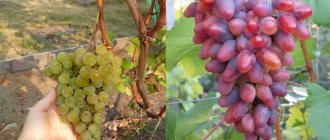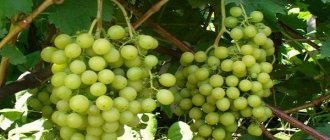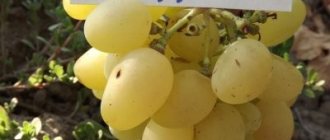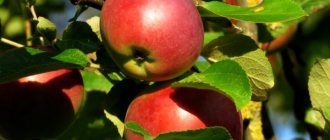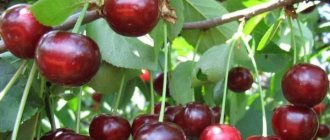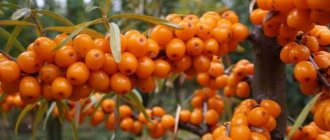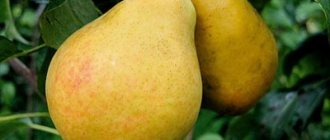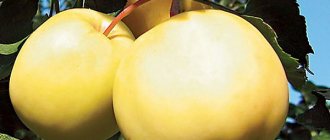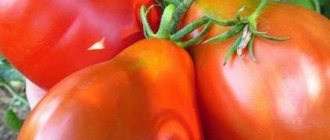Sphinx characteristics table
| General information about the variety | |
| Parent couple | Strashensky x Timur |
| Author of the variety: | V.V. Zagorulko, Ukraine |
| Main characteristics | |
| Purpose: | dining room |
| Ripening time: | very early |
| Productivity: | high |
| Taste: | harmonious, with a characteristic varietal taste |
| Color: | Navy blue |
| Frost resistance: | up to — 23°C |
| Description of a bunch of grapes | |
| Bunch weight: | 500-700 |
| Bunch density: | medium-dense |
| Description of grapes | |
| Berry shape: | oval to ovoid |
| Berry weight | 8-10 g. |
| Diseases | |
| Disease resistance: | To mildew, oidium – 3.0-3.5 points |
Winegrowers who want to get a rich harvest with minimal effort should pay attention to the Sphinx grape variety. Unpretentious in planting and care, it shows high yield results. The Sphinx grape owes its origin to the Ukrainian breeder and amateur V.V. Zagorulko. The winegrower used the Strashensky and Timur varieties as a parent pair. The resulting hybrid adopted early ripening and high yield. “Sphinx” belongs to the table varieties, which is why it is perfect for fresh consumption, making juices, compotes, jams and desserts. You will find a detailed description of the variety, technical characteristics, photos, videos of the Sphinx variety in our article.
Sphinx grapes: variety description
- The bushes are characterized by strong growth. The branches are strong, the trunk is quite massive. The leaves are medium-dissected and large in size. Flowers are bisexual.
- The bunch is large, weighing on average 700-900 grams (maximum up to 1.5 kg). The shape of the vine is cylindrical-conical.
- The berries are large (2.7-3.2 cm), ovoid or oval in shape, rich dark blue, 8-10 grams each. The pulp is tasty, aromatic and crispy. The skin is medium thick.
- The berries do not have a good presentation, do not tolerate transportation well, and the skin often cracks. At the same time, Sphinx does not lose its popularity among gardeners as a home table variety.
Varieties such as Rochefort, Ataman Pavlyuk and Asya withstand transportation better and retain their appearance.
Features of planting and growing grapes
Seedlings are purchased from plant nurseries or garden centers. In addition, you can plant self-grown Sphinx grape bushes on the plot. The pit is prepared 2-3 weeks before planting.
Landing dates
In cold regions, grapes are planted in the spring, most often in April. In this case, the bushes will have time to take root and will not freeze out in the harsh winter. In the south, planting is allowed in the fall; the most suitable month for this is October.
Note! Seedlings planted in autumn require mandatory shelter.
Site selection and soil preparation
A site for planting grapes is selected that is sunny and protected from cold winds. The bushes grow well when planted on the south side of the house. Groundwater should not come close to the soil surface, otherwise the root system may be subject to fungal diseases.
The soil is preferably fertile or loamy. Sandy soil is undesirable due to deep freezing in winter. Before planting grapes, the soil is cleared of debris and, if necessary, mineral fertilizers are applied.
How to choose the right seedling
You can purchase grape seedlings with both open and closed root systems. One-year-old bushes take root best. Plant shoots must be free of spots, dents, and other signs of disease. Before planting, the trunks are shortened to 2-3 buds, the root system is cut off by a third.
Planting process step by step
For planting, dig a hole 80 cm deep and 60 cm in diameter. If the task is to plant several bushes, leave a distance of 2 m between them. Grape bushes are planted on the plot as follows:
- Drainage is placed at the bottom of the hole.
- Then a layer of earth is poured, mixed with mineral fertilizers and organic matter.
- After this, a layer of fertile soil is laid out.
- Install the support.
- A seedling is placed in the center of the hole and covered with soil.
The tree trunk circle is watered abundantly with water and mulched.
Landing of the Sphinx
Work on planting grape seedlings begins in early April, and can continue until mid-May. Meeting the deadlines is necessary for the plant to take root properly, gain strength and become able to withstand the cold.
Some gardeners practice autumn planting in October, but this increases the risk of grape death.
For grapes, choose a place protected from gusts of wind, since drafts are destructive for the plant. It is recommended to choose southern areas. It is permissible to plant seedlings along the walls of buildings. Loamy soils are optimal for shoot growth.
See also
Description and characteristics of the Lilac Fog grape variety, care rulesRead
For planting seedlings, plants form a hole with a depth of 80 cm and a width of 20 cm. The bottom is laid out with a layer of fertile soil 15 cm thick, then a mixture of humus, superphosphate and potassium fertilizer is placed sequentially. Before planting, the seedlings are soaked in water for 48 hours, the root shoots are trimmed and 3 eyes are left.
When placed in a hole, the roots of the seedling are carefully straightened, ensuring their uniform distribution. After filling the planting site with soil, it is necessary to water it abundantly; for this, use 3 buckets of warm water.
Main characteristics
“Sphinx” is an extremely early variety with large round berries, not prone to peas, with a classic grape taste.
Ripening period
"Sphinx" belongs to the very early varieties. From the moment the buds swell in early spring until the harvest ripens, about 100-105 days pass. The ripe harvest can be harvested as early as mid-August.
The early maturity of the fruit is not at all hampered by the fact that bud burst in this variety begins quite late. Later swelling of the buds and flowering protects the crop from returning spring frosts , which occur especially often in central Russia.
Bush
The cuttings take root well and are perfectly compatible with rootstocks. The vine grows quickly and ripens early along its entire length. The bushes are vigorous with strong branches and a strong trunk.
The leaves are large and medium-dissected. Thanks to bisexual flowers, the gardener does not need to worry about additional pollination, because... the plant is self-pollinating.
In the fall, it is necessary to prepare the vine for wintering. To do this, cut off all unnecessary shoots and trim the main ones, giving the shape to the vine. For the “sphinx”, a fan-shaped bush is suitable. This formation of the vine makes it easier to process and cover the grapes for the winter. The fan arrangement of the shoots also ensures good lighting and ventilation of the bushes.
bunches
"Sphinx" is not prone to peas under favorable growing conditions. But during periods of prolonged rain, when the humidity is especially strong, gardeners often face this problem. To protect the grapes from excess liquid, water is diverted from the bushes, for example, by covering the bottom of the vine with pieces of slate.
The clusters are cylindrical-conical in shape, with a low density of berries on them. Quite large, weighing from 800 g to 1 kg.
Berries
The variety is notable for its large, round berries. The fruits reach a diameter of 3 cm and weigh from 8 to 10 grams.
The skin of the berries is dense, when fully ripe it acquires a beautiful dark blue color, and is covered with a light waxy coating on top. The pulp is crispy and juicy, contains up to 3 medium-sized seeds, which are quite noticeable when tasting.
The sugar content of the berries of this variety is variable and depends on the number of sunny days. In the warm and sunny season, fruits gain sugar up to 25%. The acidity of the berries is at the level of 5-6 g/l.
Taste
The taste is pronounced, grape, characterized by simplicity, harmony and slight sourness.
There are no special notes in the taste and aroma. Although, some winegrowers note a peculiar aroma and some marmalade of the berries.
Advantages of this variety
If we talk about the advantages of the Sphinx grape variety, among them are the following:
This variety has excellent rooting ability if propagated through cuttings. The vines of this grape ripen quite late, so it is possible to avoid the last frosts in the spring. Grapes are not prone to peas
This is especially important if the plant blooms at a time when it is very hot outside. The variety feels great in almost any climatic conditions
The Sphinx has high immunity against fungal diseases, as well as other grape pests. Grapes have an excellent taste, which is why you can prepare delicious drinks and make wonderful jam from them. It can also serve as a wonderful table decoration. The early period of the growing season means that these grapes can be sold at a high price, since at this time the market is still empty.
Advantages and disadvantages
Pros:
- It takes root well.
- Not prone to peas.
- Frost resistance.
- Versatility.
- Early ripening.
- Self-pollinating.
- Pronounced grape taste.
- Unpretentiousness.
Minuses:
- Poor transportability.
- Berries may be susceptible to cracking in high humidity conditions.
- Often damaged by wasps.
- Has average resistance to fungal diseases.
- The berries are not very attractive in presentation.
What type does it belong to?
Sphinx is a table grape with a very early ripening period.
The harvest can be harvested after 100-105 days from the growing season.
When grown in the climate of our strip, the ripening period occurs a little later. Most often, this variety is grown for eating and preparing homemade dishes (jams, salads, sweet pastries). The berries make delicious drinks (compotes, fruit drinks, wine).
Early ripening varieties also include Krasny Vostorg, Pleven and Liya.
Bunches and berries
The clusters are large, weighing from 0.8 to 1.0 kg. Cone-shaped or cylindrical brushes have a low density. The variety is notable for its large oval berries, reaching 3 cm in diameter. The average size of each berry is about 3.0 x 2.8 cm, and its weight is 10 grams. The pulp is juicy, crispy with a thick skin. When fully ripe, the berries acquire a deep blue hue with a slight waxy coating. In warm sunny summer conditions, they gain sugar content up to 25%, and the acidity level reaches 5 - 6 g/l. The taste is pleasant, aromatic.
Achimenes - growing and care at home, photos of species
Transportability is good, keeping quality is satisfactory. However, upon reaching full maturity, it is recommended to immediately collect the fruits to avoid shedding. The sales performance of Sphinx is average, but this is compensated by the amount of harvest and taste properties.
History of selection and region of breeding
Sphinx was obtained by crossing two varieties - Strashensky and Timur. The author of the variety is V.V. Zagorulko. The variety has successfully passed tests and is recommended for cultivation in many regions of Ukraine, Belarus, Moldova, as well as in our country.
The hand of the same breeder belongs to Ruta, Vodograi and Viking.
How to care for Sphinx grapes
In order for this variety to always please you with its harvest, you need to properly care for it and create suitable conditions. The grapes are regularly watered and fed.
Watering is carried out as needed, but during the period of flowering and the formation of bunches, the water rate is increased. To retain moisture in the soil, use organic mulch, which will serve as fertilizer for the plant.
Sphinx grapes, like all other varieties, are fertilized at least 3 times a season. The interval between feedings is 2-3 weeks. Fertilizing with wood ash and mineral complexes gives good results. In early spring, it is useful to foliar feed the leaves with iron sulfate. This will not only protect the bush from diseases and pests, but also replenish iron reserves in the tissues.
During the flowering period, it is useful to spray the bush with a solution of boric acid (3 g per 3 liters of water), this will contribute to the formation of good ovaries.
How to shape Sphinx grapes
Experienced winegrowers advise promptly removing old shoots that have spawned so as not to overload the bush. The best time to prune Sphinx grapes is autumn. 5 well-ripened vines with eyes are left on the plant, the rest are cut out. If the plant is young, then the shoots are only slightly shortened.
Fruiting vines are pruned to 5 buds, otherwise they will produce a lot of small and tasteless grapes.
Protecting crops from birds and insects
During ripening, grapes are especially attractive to birds and wasps. To prevent them from spoiling the bunches, you need to put a thin nylon mesh over the berries.
You should not neglect the procedure, otherwise the grapes will begin to crumble, become sick, and the yield will decrease.
Preparing the crop for winter
If the Sphinx variety is not grown in the south, then the grapes definitely need shelter for the winter. The photo shows how the vine is removed from the support and a layer of sawdust or boards is placed under it. Arcs are installed on top and the film is pulled, but so that it does not touch the branches and trunk.
They begin to cover the vines in early November, when the leaves have completely fallen off. The temperature outside was steadily cold.
Rules for caring for grapes
Caring for grapes is quite simple. The secret to getting a good harvest is choosing the right planting site, timely watering and pruning the plant.
Plants under 3 years of age require watering, which is organized according to certain rules. Each bush should have at least 4 liters, while a small amount of ash is added to the water. During the season, 3 waterings are done:
- the first - after removing the winter shelter;
- the second - at the moment of bud formation;
- the third - after flowering is completed.
Mature grape bushes do not need additional moisture. They require a single watering in the autumn before being sent under cover, which reduces the risk of shoots freezing. After this, it is important to provide timely protection from the cold.
Pinching
In order to give young shoots the opportunity to grow stronger as quickly as possible, pinching is carried out. This procedure is also often used to speed up the ripening of berries and give them more sweetness. When carrying out this procedure, the upper part of the apical part in the amount of 3 leaves is removed. It is permissible to remove 4 plates in case of late recovery from frost and the need to direct nutrients to its restoration.
Thinning and seasonal pruning
Grapes need timely thinning and pruning. The first helps to maintain sufficient air circulation and ensures free access to sunlight on the berries. It is necessary to remove dry and damaged branches. Excess shoots are pruned not only when forming the main bush, but also near the roots.
Top dressing
The first enrichment of the soil is carried out immediately before planting the seedling in the hole. Then, for 3 years, there is no special need to add additional nutrients. After this time, fertilizing with organic matter or mineral fertilizers is required. During the growing season, the plant is fed at least 3 times, the interval between procedures is from 2 to 3 weeks.
After removing the cover, the soil is enriched with nitrogen fertilizers to give the plant strength and better growth of green mass. During the flowering period, for better formation of ovaries, spray the shoots with a solution of boric acid, preparing it from 3 liters of water and 3 g of the drug. During the formation of berries, potassium superphosphate and potassium sulfate are added, and in the autumn, wood ash is added.
Mulching
Mulching provides the plant with better growth and increases productivity. To do this, a layer of plant materials 5-10 cm in size is provided around the plant. Straw, sawdust and fallen leaves are often used as a base. Mulching helps retain moisture, enriches the soil with oxygen and stimulates the intensity of activity of organisms beneficial to grapes, creating a favorable environment for them.
Autumn and spring processing
Proper pruning improves the quality of fruiting and makes the grapes stronger. The Sphinx requires work before being sent to shelter for the winter. At the same time, parts of the plant are removed, cutting off 4-6 eyes. The bushes are formed into a fan, leaving 4 sleeves. The advantage of this variety is that it does not tend to form shoots, so pruning does not take much time.
In spring, pruning is not done, as this will lead to watery eyes. The consequence of this may be the death of the plant or a significant reduction in yield. At this time, only frozen and dry shoots are removed.
Shelter for the winter
When grown in regions with cold climates, grapes require mandatory shelter. Work begins when the temperature reaches +5 C. The shoots are removed from the support, covered with earth and mulch, and arcs with agrofibre stretched over them are installed on top. It is important to prevent the effect of grape debate.
Problems during cultivation
The Sphinx variety is a variety of grape that is quite easy to grow. Early ripening and frost resistance qualities allow for good returns even in regions with difficult growing conditions. Gardeners often note the crushing of berries, which is associated with a lack of heat and the choice of a place with insufficient light. Timely pruning and feeding of the plant will help to avoid this.
Gardeners often encounter grapes freezing. Errors in this case are most often associated with incorrectly carried out cover or its late implementation. Excessive insulation leads to overheating of the shoots, and insufficient insulation leads to the inability of the plant to survive frosts or recover from excessive hypothermia in the spring.
Comparison with analogues
Vitaly Vladimirovich Zagorulko has achieved high results in 15 years of breeding work. His hybrid forms have become famous and take prizes at international exhibitions.
The goal of Zagorulko selection is to develop grape varieties distinguished by large berries, excellent presentation and excellent taste.
"Sphinx" cannot boast of high product characteristics. But thanks to its extremely early ripening period, it is highly valued because... one of the first to appear on the market. Let's consider it in comparison with the main ultra-early competitors.
| Sign | Variety | |||
| Sphinx | Elegant | Super extra | Veles | |
| Ripening period | 95-105 days | 95-105 days | 95-105 days | 100 - 110 days |
| Frost resistance | Up to -23 °C | Up to -25 °C | Up to -25 °C | -23C |
| Yield per bush | 30 kg | 15-20 kg | Up to 25 kg | 30-50 kg |
| Bunches | 500-700 g | 400-500 g | 500-800 g | 600 g – 2 kg |
| Taste | Sweet with a bright nutmeg aroma | Harmonious | Simple, moderately sweet | Muscat |
| Color | Dark blue | Yellow | Green-yellow with amber tint | Pink - amber |
| Disease resistance | High | High | Average | Above average |
| Shelf life | About 1 month | up to 1 month | A few months | Up to 3 months |
| Sugar content | Up to 25% | 20-22% | 17,40% | 17 – 22% |
| Acidity | 5-6 g/l | 4-5 g/l | 6.1 g/l | 5 - 7 g/l |
"Sphinx" is certainly worthy of growing in garden plots. Its unpretentiousness and ease of care allows even novice winegrowers to get a good harvest.
Reviews
Sphinx is an ordinary variety, not very early, as stated. the taste is simple but sweet. Vladimir, Tiraspol
The taste is good, no frills. The cluster is large, the berries are large and round. Elena Petrovna, Rostov region.
Sphinx is a bisexual variety, pollinates well, and has good disease resistance. But I don’t really like its taste (marmalade) and besides, it doesn’t hang on the bush for very long. It’s just ripe and needs to be cut right away. Irina Alexandrovna, Nikopol
Advantages
It blooms late, so it is not afraid of return frosts.
Despite its rather unpresentable appearance, the variety has many other advantages that are valued by both gardeners and buyers.
Main advantages:
- early maturation;
- high level of productivity;
- large fruits;
- large bunches;
- ease of care;
- high level of frost resistance;
- excellent taste;
- suitability for long-term transportation.
Own root bush, third fruiting.
The ripening time in central Ukraine and Russia is no more than one hundred days, but in the southern regions ripening occurs even earlier - no more than eighty days pass from the beginning of the growing season to full ripening.
Despite the rather unattractive bunches, the excellent quality of the variety is noted - there is no tendency to pea, that is, there are no small grapes on the bunch.
But the variety also does not require special conditions regarding the composition of the soil - it grows on almost all types of soil . The exception is excessively acidic soil, which should be neutralized when planting. In the southern regions, grapes do not need shelter for the winter, but in the middle zone the crop still needs to be covered.
The bright rich aroma and fresh harmonious taste suggest widespread culinary use of the Sphinx . The berries of this variety make excellent aromatic wine, sweet jams and preserves, and compotes.
Flaws
If the bunches are left on the bush, the fruits may burst.
However, everything is as rosy as we would like - there are some negative aspects:
- ugly appearance;
- tendency to crack the skin;
- susceptibility to mildew;
- susceptibility to oidium;
- demands on humidity levels.
If proper care is not taken, the skin of the grapes can crack, and the pulp deteriorates, softens, leaks, and attracts wasps.
A similar phenomenon can be observed if there is prolonged high air humidity - prolonged rains, dampness, excessive watering . Accordingly, sensitivity to humidity levels leads to the occurrence of fungal diseases - oidium, mildew .
General information about the variety
Early ripening variety.
Fairly large clusters.
Delicious berry.
It is noteworthy that among the many different varieties, Sphinx is characterized by significant unpresentability, that is, it has an unattractive appearance.
However, this fact does not prevent it from enjoying extraordinary popularity among both gardeners and consumers. The variety is quite easy to care for and does not require additional tricks to obtain good productivity results.
Peculiarities
The southern regions of Ukraine and Russia are considered their usual habitat. The plant is distinguished by its great vigor of shoots and vines.
- The bushes have a powerful structure, a wide, strong and massive rhizome.
- The leaf blades are wide with clear deep veins of light color. The leaves have three lobes, less commonly five lobes per leaf, and are rich green in color.
Bunches
The clusters have the shape of a regular cone, less often the shape of a swollen cylinder is noted.
Large bunches of Sphinx grapes.
- The weight of one brush varies within 800 grams at an average level of agricultural technology.
- If enhanced care methods are used, the weight of one bunch can reach one and a half kilograms.
- The fruits are ovoid and oval in shape . The weight of one berry is ten grams with average care.
- Strengthening agricultural techniques directly leads to an increase in fruit mass.
Berries
The berries are dark blue in color with a slight bluish tinge.
Cross section of a berry.
- The fruits are loosely adjacent to each other , which suggests some looseness of the clusters.
- The peel of the berries is juicy, dense in consistency, and slightly crunchy when bitten.
- The diameter of the fruit reaches three centimeters.
- The pulp is juicy, greenish in color, with a fairly elastic consistency, but when biting into pieces you do not hear a characteristic crunch.
Fruits and ripening times
The Sphinx is characterized by early maturation. Less than 100 days pass from the beginning of the growing season to full ripening.
Thanks to its ancestors, the variety has good frost resistance.
However, the buds ripen quite late, and this allows them to avoid the effects of late frosts. Full ripening occurs in the second half of August.
- The sugar content of one berry is twenty-five percent if the climatic conditions are warm enough, which means ripening in the southern regions.
- In cold climates, sugar content decreases to nineteen percent.
- Acidity is 6 g/l .
The variety can be called frost-resistant - the crop tolerates frost well down to 23 degrees.
Diseases and pests
The grapes are resistant to oidium and mildew within 3-3.5 points. At the same time, the gardener must not forget about carrying out preventive measures in order to avoid problems with cultivation, in time to prevent the development of diseases and pest damage. This also applies to such common grape diseases as bacterial canker, anthracnose, chlorosis, bacteriosis and rubella.
Be sure to prune grapes in the fall, when the bushes begin to prepare for winter. Leave at least 4 eyes on the shoots, cut at the rate of 4 sleeves.
To protect against pests, you need to spray the grapes with special chemicals.
Collect and burn fallen berries and leaves from the ground in a timely manner. Often they become a breeding ground for germs and pests.
Take care of the prevention and timely destruction of wild wasps, which cause a lot of damage to the crop. Place baits and traps, spray the grape bushes.
Sphinx is a favorable table variety grown by many gardeners. It has excellent taste, is frost-resistant, and is well protected from pests and diseases. It is not difficult to care for, so it can be recommended not only to an experienced gardener, but also to a beginner.
Among the unpretentious varieties, it is also worth paying attention to Aleshenkin Dar, Delight Ideal and Giovanni.
Useful video
You can visually familiarize yourself with the Sphinx grape variety in the video below:
Reproduction methods
The description says that Sphinx grapes can be propagated by layering and cuttings. The procedure is shown in more detail in the photo. However, reviews of the variety indicate that it is the cuttings that take root and bear fruit best. Diversion from grapes is possible only in the southern regions, because the roots of the plant are too sensitive to cold.
Cuttings are harvested in the fall and stored in a damp cloth in the basement until spring. For planting, shoots are used after pruning the grapes. Cuttings are cut from branches with a diameter of 7-10 mm. The middle part of the shoot is used. A good cutting has 4-5 buds. The lower edge is made oblique, directly under the kidney. The top cut is left straight.
For breeding purposes, grapes can be propagated by grafting, but the Sphinx variety is not very suitable for such manipulations.

